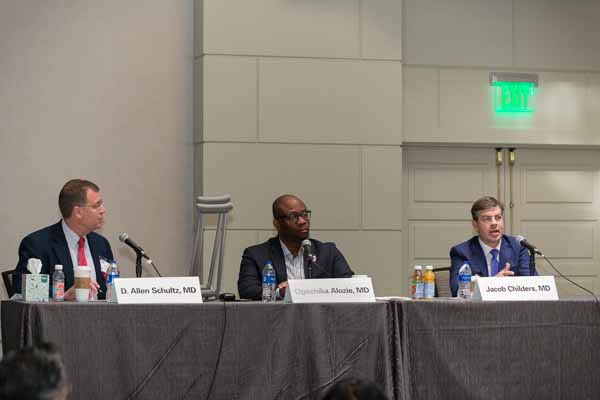
Telemedicine can provide patients with considerable convenience and satisfaction, but challenges still exist with insurance payments and bottom-line value for individual physicians.
That’s what physicians who have successfully integrated telemedicine into their practices told fellow doctors during Saturday’s Dawn Duster presentation at the 2019 Texas Medical Association Fall Conference.
A three-physician panel told early risers that patients are extremely receptive to the convenience of telemedicine for getting straightforward medical problems checked out; that telemedicine does have limitations; and that it’s part of the future of health care despite current struggles integrating it into the profession.
“There’s some cultural changes that we’re having to deal with. The physician community has to embrace it. … Patients have to adopt it. … But five to 10 years from now, we’re not going to think about this as a tele-anything. It’s just going to be health care,” said Ogechika Alozie, MD, CEO of Southwest Viral Med, an El Paso nonprofit that treats people with hepatitis C and HIV. “It’s going to be a different channel for health care.”
Abilene family physician D. Allen Schultz, MD, chair of TMA’s Telemedicine Task Force, moderated the panel discussion, which featured Dr. Alozie and Jacob Childers, MD, the medical director of eMD Access, Austin Regional Clinic’s (ARC’s) on-demand telemedicine service.
Dr. Childers said eMD has seen 98.2% patient satisfaction in its service, based on surveys ARC offers after each telemedicine encounter.
“We get extraordinary feedback, and there’s also a free-text area. So we really have a long collection of satisfied patients who describe the convenience, the fact that they didn’t have to take a half-day off work for what they thought was a pretty simple, straightforward issue,” Dr. Childers said. “What we see is the first time somebody uses it, they’re fairly amazed, because they’ve never had that ease of access.”
ARC has been moving into more value-based contracting, and in that realm telemedicine “really is a no-brainer,” Dr. Childers said. “It’s an ER avoidance tool. So in addition to that patient satisfaction and convenience … sometimes, a 5- or 10-minute telemedicine consultation will save a $3,000 ER admission. So when we’re calculating our ROI [return on investment], we actually look at that as well, the number of ER avoidances.”
Dr. Alozie warned, however, “telemedicine is not a panacea for all comers.” Sometimes patients’ conditions dictate an in-person visit, he noted. And getting insurers to pay for telemedicine services is a continuing challenge.
At one point, Dr. Alozie asked audience members to raise their hands if they were currently using telemedicine. Fewer than 10 hands went up. When he asked how many of that small group had been paid by a health plan more than 50% of the time, only a few raised their hands.
Two years ago, the TMA-backed Senate Bill 1107 established a framework for telemedicine in Texas. And during this year’s legislative session, the Texas Legislature passed new TMA-backed bills establishing telemedicine-related coverage requirements.
Over time, Dr. Alozie said, insurance companies will realize that paying for telemedicine “just makes sense, because we want to keep people out of acute care settings that don’t need acute care settings, and dollar for dollar, it’s cheaper.”
But he went on to warn that “if you’re an individual physician today, the truth is, … unless you have a unique efficiency model where you’ve run the numbers and you can do a 3-to-1, 4-to-1 calculation compared to bringing them in, [I’m not sure] it makes sense for your bottom line right now. I think it will over time.”
Dr. Childers foresees telemedicine becoming more pervasive over time, with practices finding more and more ways to leverage communication tools, and payment models changing around it.
“If I had a piece of advice to people in here who’ve not yet dipped their toe in, [it’s to] look out there and find that low-hanging fruit in your practice where you think it really makes perfect sense, and get your feet wet in that,” he said.